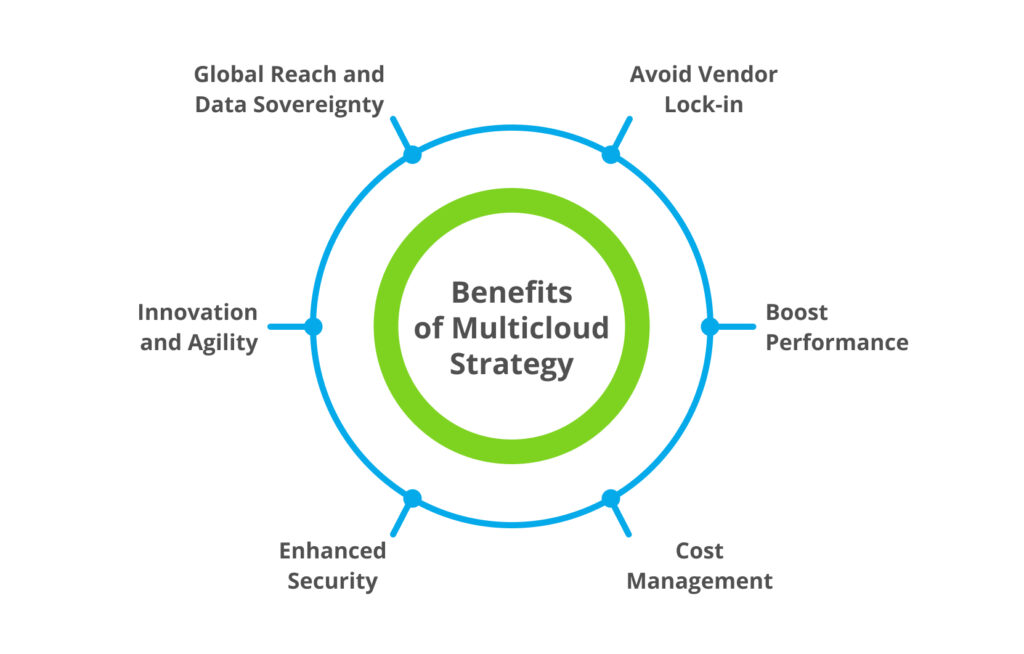In an era where cloud computing has become fundamental to business operations, the strategy of adopting a multicloud approach — leveraging cloud services from multiple cloud service providers (CSPs) — is increasingly adopted by enterprise organizations. According to a recent forecast by Gartner, worldwide end-user spending on public cloud services is expected to grow 20.4% to total $678.8 billion in 2024. Implementing a multicloud architecture enables businesses to select the best cloud products and services, optimizing performance and controlling costs while preventing vendor lock-in.
- What is multicloud architecture?
- The Hybrid Multicloud Environment
- Challenges of Multicloud
- 8 Steps for Creating a Successful Multicloud Strategy
- Benefits of Multicloud
What is multicloud architecture?
Multicloud architecture involves integrating multiple cloud services from more than one of the major CSPs into the same IT infrastructure. This can range from simple Software-as-a-Service (SaaS) applications to complex arrangements for Platform-as-a-Service (PaaS) and Infrastructure-as-a-Service (IaaS), encompassing data storage, application development, testing, and disaster recovery.
The Hybrid Multicloud Environment
The hybrid multicloud environment merges multicloud with hybrid cloud models to support the interoperability and portability of workloads across various settings, including public clouds, private clouds, and on-premises infrastructure. This environment supports cloud-native application development, leveraging container orchestration platforms like Kubernetes to facilitate DevOps methodologies and enhance software deployment.
Challenges of Multicloud
Navigating a multicloud strategy comes with challenges such as cloud sprawl, data silos, security risks, and uncontrolled costs. These can complicate cloud management, leading to potential data breaches, increased multicloud attack surface, and difficulty in managing cloud financial management.
Let’s delve deeper into the intricacies of multiclouds.
- Cloud Sprawl: Difficulty in managing diverse services leading to cost inefficiencies.
- Data Silos: Isolated data across platforms hindering analytics and decision-making.
- Security Risks: Complex security management increasing vulnerability to threats.
- Uncontrolled Costs: Challenges in tracking and optimizing expenses across platforms.
- Integration and Interoperability: Technical hurdles in combining disparate cloud services.
- Management Complexity: Navigating multiple interfaces and maintaining compliance.
- Network Performance: Issues with latency and connectivity affecting user experience.
- Vendor Lock-in: Potential dependencies despite a multicloud approach.
8 Steps for Creating a Successful Multicloud Strategy
- Define Goals: Align your business goals with your multicloud objectives, considering your existing cloud infrastructure and specific workload requirements.
- Select the Best Cloud Service Providers: Choose CSPs based on their performance, unique services, and the value they bring to your multicloud architecture.
- Create a Single Pane of Glass: Implement a centralized cloud management platform (CMP) for greater visibility and control over your multicloud ecosystem.
- Leverage Automation Tools: Incorporate cloud automation, Infrastructure-as-Code (IaC), and orchestration tools to streamline multicloud management.
- Build a Zero-Trust Security Approach: Develop a zero-trust security framework across all cloud services to mitigate security risks and enhance data protection.
- Integrate Compliance and Regulatory Requirements: Ensure your multicloud strategy complies with global regulatory standards and industry-specific regulations.
- Adopt FinOps for Cost Optimization: Apply FinOps principles for better cloud cost optimization and financial management across your multicloud setup.
- Continuously Refine Your Multicloud Strategy: Regularly review and adjust your strategy to adapt to business changes and leverage new cloud technologies.
Colobridge’s Expert:
«Not all companies are ready to adopt a multi-cloud approach right now due to security risks, complexities in cost control, and overall infrastructure management. However, all these challenges can be effectively overcome by adhering to the recommendations provided above. If you encounter difficulties at any stage or require expert assistance, the specialists at Colobridge are ready to help. We have accumulated sufficient expertise to act as partners in the implementation of even the most ambitious projects – infrastructure solutions of any complexity. Furthermore, the technical conditions for hosting your data (two independent data centers in Frankfurt) create opportunities for connecting to various cloud providers, including hyperscalers».

Benefits of Multicloud
A well-implemented multicloud strategy offers benefits such as avoiding vendor lock-in, optimizing for cost and performance, ensuring operational high availability, and improving cloud security and data protection.
- Avoid Vendor Lock-in: Effortlessly switch between providers to leverage the competitive advantages of each.
- Boost Performance: Optimize application speeds by selecting AI and machine learning capabilities for data-driven projects or AWS’s global reach for international user bases.
- Enhanced Security: Diversify security risks and comply with regional data laws by using local CSPs.
- Innovation and Agility: Access the latest technologies and adapt to market changes quickly.
- Global Reach and Data Sovereignty: Store and process data according to local regulations by deploying services in specific regions.
Adopting a multicloud approach is essential for businesses seeking flexibility, innovation, and cost efficiency in their digital transformation journeys. By following these eight steps, organizations can develop a comprehensive multicloud management strategy that aligns with their operational goals and mitigates the inherent challenges of managing multiple cloud environments.
Ask Colobridge experts how to specifically implement a multicloud strategy on our platform with the ability to connect to hyperscalers.

